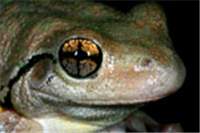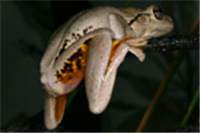Family
Hylidae
Genus
LitoriaSpecies
peroniiThreats/Control Methods - Regional
Despite L. peroni currently not thought to be at risk it is important to take care when entering frog habitats at all times, due to the risk of spreading disease, including the Chytrid fungus (chytridiomycosis). To prevent the spread of the Chytrid fungus it is important to wash your shoes before entering AND after leaving frog habitats. For more information on the Chytrid fungus -http://www.deh.gov.au/biodiversity/invasive/publications/c-disease/
Local/Urban Actions
You can encourage frogs into your own backyard by including habitat features in your garden. The Ginninderra Catchment Group, Australian National University and Environment ACT have developed a guideline to help you encourage frogs into your backyard called Creating a Frog Friendly Habitat in the ACT Community.
Making Frog friendly gardens provides frogs with new habitats, helping to replace those lost through urbanisation.You can also get involved in monitoring local frog populations. Frogwatch is an annual program run to monitor the presence and abundance of frogs within the ACT region. The Frogwatch program provides training for community volunteers each October, with monitoring then being undertaken by volunteers over a two week period.
For more information on Frogwatch contact:The ACT Frogwatch Coordinator, Ginninderra Catchment Group; Ph (02) 6278 3309 or email: [email protected]
Distinguishing Features
Adults range from 4.3- 7cm in length, and have broad round toe disks to aid in climbing, the body is grey/brown or cream in colour and is speckled with emerald green flecks. The pupil of the eye has a cross-like appearance. Tadpoles are pale golden-yellow to iridescent green. The easiest way to identify this species is by its call, which gives light to some of its more unusual common names such as Maniacal Cackle Frog. The call can be described as a low descending rattle or a ©cra©ah©ah©ah©ah ©ah©ah©ah©ahhk©.
Common name/s
Peron's Tree Frog, Emerald-Spotted Tree Frog, Laughing Tree Frog, Maniacal Cackle Frog
Distribution
Found throughout the south east corner of QLD, extending across much of the NSW QLD border, and eastern NSW, and in patches across Victoria. Distribution is limited in SA to a thin band following the lower Murray River.
Country of Origin
Australia
Survey Techniques
The most common technique for monitoring frog populations is based on call identification, with each frog species having a unique call. Frogs should not be handled without the use of sterile gloves, as their skin is very sensitive to chemicals, including sunscreen and soap.
Conservation (Pet/Pest) Status - National
Currently not thought to be at risk
Conservation (Pet/Pest) Status - Regional
Currently not thought to be at risk
LSCCES Population
Within the ACT the population is thought to be stable. During the 2004 Frogwatch census Litoria peroni was detected in 26% of the sites surveyed.
Associated Vegetation Community
Forests, woodlands, shrublands. This species also occurs in disturbed sites, particularly open areas and farm dams.
Limiting Resources
Requires permanent water bodies for both habitation and breeding.
Breeding
The males can be heard calling from September through to January, breeding occurs from September though to December. Eggs are found as pigmented jelly at the waters edge.
Behaviour
Males often call from partially submerged water bodies, such as reeds or logs, or from dead trees. The arboreal nature of the species often finds them climbing trees, or even windows, in search of insects.
Functional Group
Insectivorous
Food Species
Small insects including beetles and moths.
Predators
May include native birds, such as the White-Faced Heron (Egretta novaehollandiae) and Intermediate Egret, and fish, including the introduced Carp, Goldfish and Trout. Introduced species such as Cats (Felis catus) and Foxes may also predate on frogs.
Interesting Fact
Reports of L. peroni calls being heard up to a kilometre from the frog have been made!
References - (reader suitability of references, P=Primary teachers, S=Secondary students, T=Tertiary students and researchers)
Books:
Barker, J., Grigg,G., Tyler, M. (1995). A Field Guide to Australian Frogs. Surry Beatty & Sons. NSW, Australia. S, TLintermans,M. & Osborne, W. (2002). Wet & Wild: A Field Guide to the Freshwater Animals of the Southern Tablelands and High Country of the ACT and NSW. Environment ACT. Canberra, Australia. S, TRobinson, M. (1993). A Field Guide to Frogs of Australia. Australian Museum/Reed books. NSW, Australia. S, TTurner, J. (2004). Frogs of Australia. Pensoft. Bulgaria. P, STyler, J. (1994). Australian Frogs: A Natural History. Reed New Holland. Australia. S, TSwan, G.(2001). Green Guide: Frogs of Australia. New Holland Publishers. Sydney, Australia. P, S
Online Publications:
Amphibian Research Centre. (2005). Available Online: http://frogs.org.au/frogs/species/Litoria/peroni/ S, TDepartment of Environment and Heritage, (2004) Chytridiomycosis Factsheet http://www.deh.gov.au/biodiversity/invasive/publications/c-disease/ S, TEnvironment ACT. (2004). Summary of results. Available online: http://www.environment.act.gov.au/Files/frogwatchoctober2004summary.pdf P, S, TEnvironment ACT. Litoria peroni. Available online: http://www.environment.act.gov.au/Files/frogwatchoctober2004-litoriaperoniiresults.pdf S, TZoological Parks and Gardens Board. Frog Pond Checklist. Available Online: http://www.zoo.org.au/education/factsheets/amp-frog_pond_checklist.pdf P, S, TSpeare, R et al (1998). HOW TO REDUCE THE RISKS OF YOU TRANSMITTING AN INFECTIOUS AGENT BETWEEN FROGS AND BETWEEN SITES. Available Online: http://www.jcu.edu.au/school/phtm/PHTM/frogs/prevent.htm S, TZoological Parks Board N>S>W. (2005.). ASX Frog Focus. Available online: http://www.asxfrogfocus.com/ P, S (School activity program)
Researcher:Pippa Jaminon


 Top
Top Top
Top